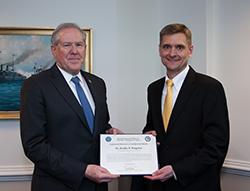Dr. Bradley Ringeisen Named Department of Defense Scientist of the Quarter for His Work with a Novel Form of 3D Bioprinting
New developments in the 3D printing of human tissue have been cropping up in the headlines with increasing frequency lately; in my opinion, bioprinting is one of the most exciting 3D printing applications in existence. It’s not as new as you may think, though; the technology has been in development for over a decade. Dr. Bradley Ringeisen, Head of the Bioenergy and Biofabrication Section for the chemistry division of the United States Naval Research Laboratory (NRL), is one of the pioneers of bioprinting, and he was recently recognized as the Department of Defense Scientist of the Quarter for the work he has been doing in the field since 2000.

Mr. Stephen P. Welby, Acting Principal Deputy Assistant Secretary of Defense for Research and Engineering Performing the Duties of the Assistant Secretary of Defense for Research and Engineering, Dr. Melissa L. Flagg, Deputy Assistant Secretary of Defense for Research, Mr. John Montgomery, NRL Director of Research, Mr. Frank Kendall, Under Secretary of Defense for Acquisition, Technology and Logistics, Dr. Bradley R. Ringeisen, Head of the Bioenergy and Biofabrication Section in the Chemistry Division at NRL
If you’ve been following the latest developments in bioprinting, you’ll know that several companies and research organizations have stepped into the arena with new methods for printing cells, tissues, and even organs. While the methods vary from company to company, most bioprinting techniques involve the use of “inks” created from stem cells mixed with nutrient-fortified gels or liquids to print soft tissue. While printers have been developed specifically for the purpose of bioprinting, standard printers have also been used; it’s the same extruder-based process that the most common 3D printers use. Dr. Ringeisen, who began working for NRL as a post-doctoral associate before being hired full time in 2002, developed a very different method.
That method is known as Biological Laser Printing, or BioLP, and it’s been patented by the NRL, which, in its patent application, describes the technology as:
“A method for creating a microarray of proteins and other biomaterials that uses focused laser pulses to transfer material from a three layer target onto a receiving substrate. The transparent support layer allows a laser pulse to focus at its interface with the absorbant coating layer causing the biomaterial to be propelled to a specific location on the receiving substrate.”
Those biomaterials can be cell inks, gels or solids, as well as soil and sediment or biomolecules. Dr. Ringeisen was the first to print both mammalian and bacterial cells using the technology, and he has since developed it further by adding a laser absorption layer to protect the biomaterials from the lasers’ potentially damaging ultraviolet light.
“BioLP is unique because it does not use a traditional micro-tube or capillary-based printhead,” said Dr. Ringeisen. “Therefore, BioLP cannot clog and has been used to print a variety of materials….BioLP has also been used in conjunction with Navy-patented biodegradable biopapers that can be easily printed to and then stacked to create 3D tissue mimics. These biopapers have been created with a range of material properties that mimic soft and hard tissues, whereas all other bioprinters are relegated to printing liquid inks and subsequently form soft tissues only.”
Dr. Ringeisen and his colleagues were the first to use BioLP to print viable microorganisms directly from soil samples, opening the possibility for the discovery of new microorganisms and enzymes that could be used for everything from new antibiotic development to carbon sequestration and biofuels. The technology has already been used to 3D print “highways of surrogate cells” to regrow neurons in the spinal cord, and the potential lifesaving applications of BioLP are many. The NRL hopes to use it in the future for the treatment of common military ailments like traumatic brain injury (TBI), radiation exposure, burns and hearing loss.
Dr. Ringeisen is furthering bioprinting research with the recent establishment of a DoD Bioprinting Consortium, which is bringing the NRL together with the Uniformed Services University for the Health Sciences and the Walter Reed National Military Medical Center to study potential treatments for TBI and radiation exposure, as well as skin replacement therapies, using bioprinting technology.
If you’d like to learn more about BioLP, you can check out this article co-authored by Dr. Ringeisen, or this one.
Subscribe to Our Email Newsletter
Stay up-to-date on all the latest news from the 3D printing industry and receive information and offers from third party vendors.
You May Also Like
Further Understanding of 3D Printing Design at ADDITIV Design World
ADDITIV is back once again! This time, the virtual platform for additive manufacturing will be holding the first-ever edition of ADDITIV Design World on May 23rd from 9:00 AM –...
3D Printer Maker EVO-tech Reborn as NEVO3D — Once More With Feeling
EVO-tech was a 3D printing service and original equipment manufacturer established in 2013 and based in Schörfling am Attersee, Austria. The company produced high-quality material extrusion systems featuring linear bearings,...
3D Systems Brings 3D Printed PEEK Cranial Implant to the U.S. with FDA Clearance
For more than 10 years, 3D Systems (NYSE:DDD) has worked hand-in-hand with surgeons to plan over 150,000 patient-specific cases, and develop more than two million instruments and implants from its...
CDFAM Returns to Berlin for Second Annual Symposium
The second CDFAM Computational Design Symposium is scheduled for May 7-8, 2024, in Berlin, and will convene leading experts in computational design across all scales. Building upon the first event...

































